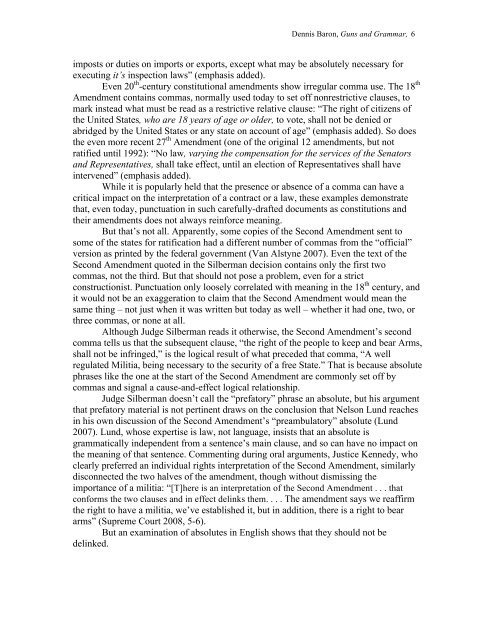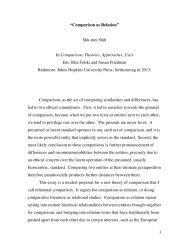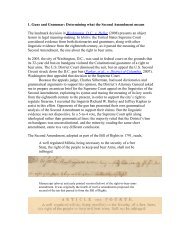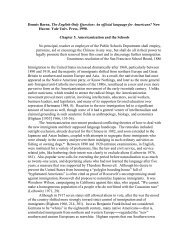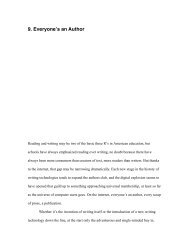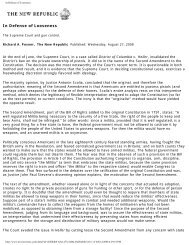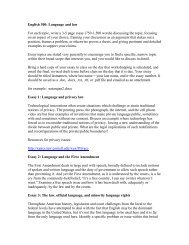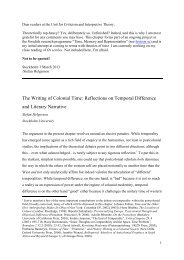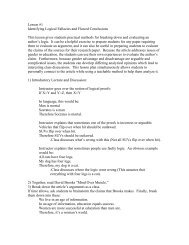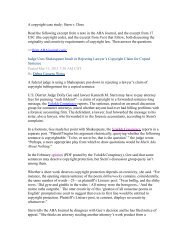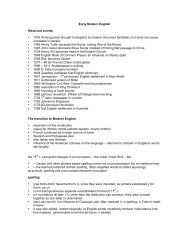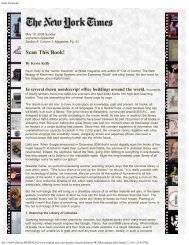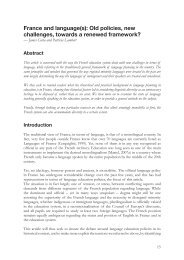Guns and Grammar: the Linguistics of the Second ... - English
Guns and Grammar: the Linguistics of the Second ... - English
Guns and Grammar: the Linguistics of the Second ... - English
You also want an ePaper? Increase the reach of your titles
YUMPU automatically turns print PDFs into web optimized ePapers that Google loves.
Dennis Baron, <strong>Guns</strong> <strong>and</strong> <strong>Grammar</strong>, 6<br />
imposts or duties on imports or exports, except what may be absolutely necessary for<br />
executing it’s inspection laws” (emphasis added).<br />
Even 20 th -century constitutional amendments show irregular comma use. The 18 th<br />
Amendment contains commas, normally used today to set <strong>of</strong>f nonrestrictive clauses, to<br />
mark instead what must be read as a restrictive relative clause: “The right <strong>of</strong> citizens <strong>of</strong><br />
<strong>the</strong> United States, who are 18 years <strong>of</strong> age or older, to vote, shall not be denied or<br />
abridged by <strong>the</strong> United States or any state on account <strong>of</strong> age” (emphasis added). So does<br />
<strong>the</strong> even more recent 27 th Amendment (one <strong>of</strong> <strong>the</strong> original 12 amendments, but not<br />
ratified until 1992): “No law, varying <strong>the</strong> compensation for <strong>the</strong> services <strong>of</strong> <strong>the</strong> Senators<br />
<strong>and</strong> Representatives, shall take effect, until an election <strong>of</strong> Representatives shall have<br />
intervened” (emphasis added).<br />
While it is popularly held that <strong>the</strong> presence or absence <strong>of</strong> a comma can have a<br />
critical impact on <strong>the</strong> interpretation <strong>of</strong> a contract or a law, <strong>the</strong>se examples demonstrate<br />
that, even today, punctuation in such carefully-drafted documents as constitutions <strong>and</strong><br />
<strong>the</strong>ir amendments does not always reinforce meaning.<br />
But that’s not all. Apparently, some copies <strong>of</strong> <strong>the</strong> <strong>Second</strong> Amendment sent to<br />
some <strong>of</strong> <strong>the</strong> states for ratification had a different number <strong>of</strong> commas from <strong>the</strong> “<strong>of</strong>ficial”<br />
version as printed by <strong>the</strong> federal government (Van Alstyne 2007). Even <strong>the</strong> text <strong>of</strong> <strong>the</strong><br />
<strong>Second</strong> Amendment quoted in <strong>the</strong> Silberman decision contains only <strong>the</strong> first two<br />
commas, not <strong>the</strong> third. But that should not pose a problem, even for a strict<br />
constructionist. Punctuation only loosely correlated with meaning in <strong>the</strong> 18 th century, <strong>and</strong><br />
it would not be an exaggeration to claim that <strong>the</strong> <strong>Second</strong> Amendment would mean <strong>the</strong><br />
same thing – not just when it was written but today as well – whe<strong>the</strong>r it had one, two, or<br />
three commas, or none at all.<br />
Although Judge Silberman reads it o<strong>the</strong>rwise, <strong>the</strong> <strong>Second</strong> Amendment’s second<br />
comma tells us that <strong>the</strong> subsequent clause, “<strong>the</strong> right <strong>of</strong> <strong>the</strong> people to keep <strong>and</strong> bear Arms,<br />
shall not be infringed,” is <strong>the</strong> logical result <strong>of</strong> what preceded that comma, “A well<br />
regulated Militia, being necessary to <strong>the</strong> security <strong>of</strong> a free State.” That is because absolute<br />
phrases like <strong>the</strong> one at <strong>the</strong> start <strong>of</strong> <strong>the</strong> <strong>Second</strong> Amendment are commonly set <strong>of</strong>f by<br />
commas <strong>and</strong> signal a cause-<strong>and</strong>-effect logical relationship.<br />
Judge Silberman doesn’t call <strong>the</strong> “prefatory” phrase an absolute, but his argument<br />
that prefatory material is not pertinent draws on <strong>the</strong> conclusion that Nelson Lund reaches<br />
in his own discussion <strong>of</strong> <strong>the</strong> <strong>Second</strong> Amendment’s “preambulatory” absolute (Lund<br />
2007). Lund, whose expertise is law, not language, insists that an absolute is<br />
grammatically independent from a sentence’s main clause, <strong>and</strong> so can have no impact on<br />
<strong>the</strong> meaning <strong>of</strong> that sentence. Commenting during oral arguments, Justice Kennedy, who<br />
clearly preferred an individual rights interpretation <strong>of</strong> <strong>the</strong> <strong>Second</strong> Amendment, similarly<br />
disconnected <strong>the</strong> two halves <strong>of</strong> <strong>the</strong> amendment, though without dismissing <strong>the</strong><br />
importance <strong>of</strong> a militia: “[T]here is an interpretation <strong>of</strong> <strong>the</strong> <strong>Second</strong> Amendment . . . that<br />
conforms <strong>the</strong> two clauses <strong>and</strong> in effect delinks <strong>the</strong>m. . . . The amendment says we reaffirm<br />
<strong>the</strong> right to have a militia, we’ve established it, but in addition, <strong>the</strong>re is a right to bear<br />
arms” (Supreme Court 2008, 5-6).<br />
But an examination <strong>of</strong> absolutes in <strong>English</strong> shows that <strong>the</strong>y should not be<br />
delinked.


